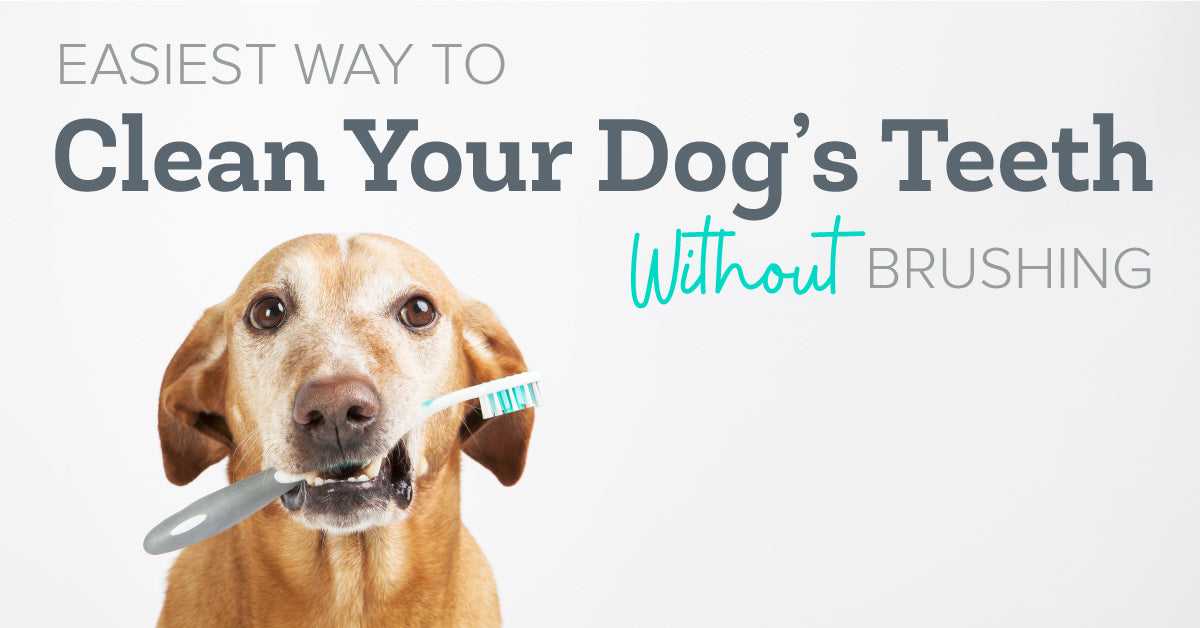Easiest Way to Clean Your Dog’s Teeth Without Brushing
Is it time to give your dog’s smile a new leash on life? If you’re noticing stinky dog breath and pearly whites that look a bit, well, yellow, the answer is a resounding YES. But if you tremble at the thought of brushing your dog’s teeth, not to worry. Keep reading and we’ll give you the scoop on the easiest way to deliver dog fresh breath and get their teeth clean – no toothbrush required!
Is it Bad Not to Brush Your Dog’s Teeth?
We’re not here to point fingers – only to get those tails wagging. So if you haven’t been brushing your dog’s teeth, don’t be too hard on yourself. This chore is difficult for even the most dedicated pet parents – you know, the ones with the bumper sticker, “My Corgi is smarter than your Honor Student.”
The truth is, in order to be beneficial to their oral health, dog tooth brushing needs to be done, at a minimum, 3 times a week. Ideally, it should happen every day. That’s hard to do with our busy, on-the-go lifestyles.
Not only that, but some dogs just don’t take to tooth brushing right away. They either run, jerk their heads away, or just chew on the toothbrush. (That’s why flavored toothpastes are not the best idea, and it’s recommended to use a flavor-free pet toothpaste.)
Getting a dog used to toothbrushing therefore requires truckloads of patience from the pet parent. For those who may be a load short in that department, other alternatives are often sought out. (If you DO want to give tooth brushing a whirl, check out “How to Brush Your Dog’s Teeth … Without Losing Your Sanity.”)
So perhaps instead of the question, “Is it bad not to brush my dog’s teeth?” we should instead be asking: “Is it bad to neglect my dog’s oral care?”
The answer to that question is yes. Just like humans, dogs need regular oral care to keep their breath from wilting flowers, and to keep their teeth free of plaque and tartar.
What Happens When a Dog’s Oral Care Is Neglected?
If you give your dog’s teeth the brush-off, a buildup of plaque – a sticky, gummy clear substance that naturally forms on the teeth after meals – will eventually harden into tartar. This hardened surface provides a perfect base for bacteria to multiply and thrive. Bacterium is what causes bad dog breath and leads our pets down the perilous path of gum disease.
Tartar, also known as calculus, is easy to spot. Look at your pet’s teeth. If you see yellow or brown buildup, normally near the top of the teeth near the gums, that’s tartar.
Tartar occurs when plaque interacts with the salts in a dog’s saliva. This process can begin in just 1–2 days and immediately start to irritate their gums.
So the key to dog fresh breath and keeping your furry friend’s smile healthy is to remove plaque from your dog’s teeth BEFORE it hardens into tartar. Tartar can only be removed with a professional dental cleaning, which can cost hundreds of dollars, as it requires pets to be put under anesthesia.
Tartar buildup that goes unchecked will start to impact the health of your pooch’s gums, which can eventually lead to chronic periodontal disease.
What Is Periodontal Disease in Dogs?
Periodontal disease (advanced gum disease) is an infection and inflammation of the periodontium, the tissues that surround and support a dog’s teeth. This disease is super common in dogs. In fact, it’s the #1 clinical disease affecting our pets.
By the age of 3, more than 80% of dogs already have some form of gum disease, which occurs in four stages (more on that in a sec). The good news is, in its early stages, gum disease is completely reversible.
Conversely, if gum disease is ignored, it will eventually get so bad that the teeth will separate from the gums. Painful to say the least! Sadly though, even though our dogs know plenty of tricks like sit, stay and shake, they don’t know the one where they can tell us when they’re in pain. You’ll need to be on the lookout for their nonverbals that indicate pain.

And if you’re really in tune with your pet, you may notice that his facial expressions seem a little “off.” You may notice a vacant stare, a glazed-over, sleepy look, enlarged pupils, or flattened ears. Take these little cues seriously, trust your intuition, and make an appointment with the vet if you notice more than one pain indicator.
Not only can periodontal disease affect the quality of our dogs’ lives, but also the quantity. It’s estimated that periodontal disease can take 2–5 years off a dog’s life. That’s because when bacteria from a gum infection circulates through the bloodstream, it can affect our dogs’ vital organs, from the kidneys to the heart.
Our dogs need us to be proactive in their dental care, knowing the signs of periodontal disease, and taking the stance of prevention is the best measure.
What are the signs of periodontal disease?
At first you may not notice a problem other than the occasional blast of bad breath, but then you may start to notice a few tell-tale signs of gum disease:
- Stinky breath (anything beyond “mild” should be a red flag)
- Trouble picking up food or chewing it
- Red or swollen gums (Normal gum tissue should be light pink with no redness)
- Yellow or brown teeth
- Loose or missing teeth
- Bloody saliva – you may notice this on toys or in their water bowl
Whether your dog has any symptoms or not, adopting a home dental routine is one of the best things you can do for their health and happiness. You’ll also want to regularly inspect their gums to make sure they are not red or swollen.
4 Stages of Dog Periodontal Disease
Stage 1: Mild Gingivitis
At this stage, your dog’s smile is still pretty healthy. But silently and stealthily, plaque is starting to build up. Gingivitis (inflammation of the gums) will be mild and your dog may have some sensitivity and occasional bad breath.
At this stage, periodontal disease is completely reversible. You’ll want to make sure you adopt a regular dental routine at home to keep their smile in good shape.
I spy with my little eye: One of the easiest ways to spot stage one periodontal disease is to look for a thin red line on the gums next to the dog’s teeth.
Stage 2: Moderate Gingivitis
In this stage, you’ll see visible inflammation and swelling of the gums. Plaque will cover a large portion of the dog’s teeth, and you’ll probably notice some spots with tartar too. Their breath will definitely be stinky.
That red line on the dog’s gums will likely be wider and more prominent. This is a problem because, besides the pain it can put your pup in, it can adversely affect their immune system, often leading to infections.
At this point, home care is not enough. A veterinarian will need to see your dog for a professional cleaning. Once that happens though, and you kick home dental care into high gear, periodontal disease is still reversible.
Stage 3: Periodontitis
At this stage, gingivitis has progressed and is now classified as periodontitis. Serious periodontal damage has occurred, which is risky to the dog’s overall health. Sadly, most pet parents don’t notice a problem until periodontal disease has reached this stage.
What will you notice in stage 3? The gums will be irritated and swollen and also bleed easily. Inflamed sections of gum known as periodontal pockets will start to show because of subgingival bacterial invasion.
Some bone loss has probably occurred by now because of bacterial toxins being released. You’ll definitely be able to see tartar buildup around the base of the dog’s teeth.
Bad breath is likely becoming worse each day. Besides causing discomfort, a big concern here is the bacteria traveling from the dog’s mouth into the bloodstream. This can affect the health of the pet’s kidneys, liver and heart. Although worrisome, periodontal disease at this stage is treatable with professional dental care and dedicated at-home care.
Stage 4: Chronic Periodontal Disease
Now established and chronic, periodontal disease in stage 4 is considered extreme. At this point, there is severe inflammation, gum recession, deep periodontal pockets, bone loss, tooth mobility and profuse bleeding. Unfortunately, extensive and irreversible damage has already happened.
If a dog’s smile has gotten to this point, it’s very important to have it checked out by a veterinarian as soon as possible.
Remember: the reason for this urgency is that extreme periodontal disease can cause other health problems, including complications with the heart and kidneys, putting the dog’s life at risk.
Additionally, any previous symptoms and problems have likely gotten worse. Because periodontal disease is very painful at this point, getting a veterinarian to intervene is a matter of compassion for the dog.
A routine cleaning will not fix anything when periodontal disease has reached stage 4. It’s likely that tooth extractions and other dental interventions will be required. Extensive post-surgical care will be needed after the operations, including frequent and thorough cleanings, medicine application and feeding. After the healing period is over, regular cleaning will help maintain the dog’s newly improved smile.
A Quick Word About Dog Dental Chews: Dog dental chews can be a great way to support your dog’s oral care, but they should never substitute for a home dental routine. (And it can be unhealthy if you overdo it, as they can put your dog at risk for obesity.) Additionally, if your dog is in stage 3 or 4 of periodontal disease, you may want to avoid certain chews. They may simply be too hard on teeth that are already weak and loose. (Think items like hooves, antlers, Nylabones, etc.)
Introducing Oxyfresh Dog Water Additive: 10-Second Solution for Fresh Dog Breath & Healthy Smiles
Oxyfresh Pet Dental Water Additive for dogs (cats too!) is the answer to pet parents who don’t have the time or desire to brush their dog’s teeth, but still want to give them the best home care possible.
This fast-acting, USA-made dog breath water additive provides fresh dog breath and plaque-fighting powers without harmful masking agents like mint, clove, green tea, or tea tree oils. (Seriously, even though our dogs may eat out of the trash, they don’t want their water bowls messed with.)
In fact, unlike most other dog water additives on the market, our special Oxyfresh formula is 100% tasteless and odorless so your dog won’t even know you’re giving it to them. (See! We CAN outsmart our pets!)
Best of all, it’s just so easy! Simply add 1 capful solution into your dog’s water bowl each day. That’s it! This process literally takes just 10 seconds … even less if you have a spring in your step. Home dental care for dogs does not get any easier than with Oxyfresh Pet Dental Water Additive.
Oxyfresh dog water additive is a 2020 Family Choice Award Winner, which means it’s the best of the best and trusted by families for its quality and effectiveness. Veterinarians recommend it and your dog will love it!
Just how does Oxyfresh Pet Dental Water Additive deliver fresh breath for dogs?
Our secret is Oxygene®, a gentle, non-toxic ingredient that safely neutralizes bad breath-causing bacteria on contact. It also slows the bacteria that causes plaque, helping in the fight against tartar and periodontal disease. No other dog breath water additive out there has this special ingredient.
If science is your jam, here’s a deeper dive into how Oxygene® works for fresh dog breath. Bad breath is caused by volatile sulfur compounds (VSCs). Oxygene® is a pure, stabilized form of chlorine dioxide – don’t let the word “chlorine” scare you … this is not the same stuff that goes into swimming pools! – that breaks the sulfur bonds (stinky) via the gentle process of oxidation and converts them into sulfite ions (odor free). Just like your dog with a piece of turkey, the bad breath is gone in an instant! And there are no harmful byproducts emitted in this process.
Pet parents who swear their dogs have the worst breath on the block (or planet for that matter), report how quickly it turns that bad doggie breath into snuggly-close puppy breath with a noticeable difference in the amount of plaque on their teeth.
Why You’ll Love It
DOG FRESH BREATH – Finally say goodbye to bad doggie breath with our fast-acting formula. We don’t just mask bad pet breath; we safely neutralize it at the source.
CLEAN TEETH AND GUMS – The easiest way to clean dogs’ teeth, fight periodontal disease, and strengthen their gum tissue.
NO BRUSHING – It’s so easy … just add a capful to your dog’s drinking water each day. It’s completely safe to drink.
ODORLESS, TASTELESS & NO FLAVOR ADDITIVES – Our professional-strength dog breath water additive has zero flavor additives, including mint, clove, green tea, etc., making it perfect for even the pickiest dogs.
IT WORKS – Trusted by pet parents and veterinarians to provide fresh breath for dogs, and just like all Oxyfresh products, our Dog Water Additive for healthier pet teeth and gums is made in the USA with only the highest quality ingredients.
What Pet Parents Are Saying About Oxyfresh Dog Water Additive
Instant improvement for doggie breath!
This month I adopted a 15-year-old dog with horrible teeth and breath. I started her on the water additive and her breath improved immediately!
Venda S.
More effective than dental treats!
Our dogs had atrocious breath. We purchased toys and treats with no results. In ONE DAY of using this, their breath was much better!
Maria B.
It’s so worth it!
Once again my senior dog didn’t need her teeth cleaned because she’s been on the water additive now for 5 years. It’s the best!
Sonia A.
My vet loves it!
The vet loves the way my dogs’ gums and teeth look. And their breath is so fresh! I would recommend to any pet owner.
Susan T.
Do you believe in miracles?
After a week of giving my dogs this miracle liquid, their bad breath is gone, and the tartar is going away, even on my older dog’s teeth.
Cynthia M.
The gift of a healthy smile is priceless to the happiness and well-being of our furry companions. And let’s be honest, time spent with our pets is a lot better when they have fresh dog breath.
So don’t delay in starting a home dental routine. Oxyfresh has your back – and your dog’s smile – with a full line of non-toxic, eco-friendly pet dental products available at oxyfresh.com – yes, including our popular Pet Dental Water Additive, the most convenient, no-fuss way to get fresh breath for dogs. Woof!



